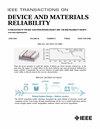A Lifetime Prediction Method of IGBT Based on Phased Nonlinear Wiener Process
IF 2.3
3区 工程技术
Q2 ENGINEERING, ELECTRICAL & ELECTRONIC
IEEE Transactions on Device and Materials Reliability
Pub Date : 2025-06-02
DOI:10.1109/TDMR.2025.3575598
引用次数: 0
Abstract
The Insulated Gate Bipolar Transistor (IGBT) is a critical component of power electronic devices, and its reliability significantly impacts the overall system performance. To enhance IGBT reliability assessment in the context of modular multilevel converters (MMCs), this study proposes a remaining useful life (RUL) prediction method based on a phased nonlinear Wiener process. By analyzing the failure mechanisms of IGBTs, the turn-off peak voltage and the collector-emitter saturation voltage are identified as key degradation indicators. A piecewise nonlinear Wiener degradation model is employed for RUL prediction, with gradient change detection method used to dynamically determine segmentation points. The proposed model accounts for the stochastic effects of the drift coefficient and measurement errors, with Kalman filtering algorithm applied to update random parameters in real time. Based on accelerated aging test data, the proposed method is compared with the standard Wiener model, the Wiener model considering only drift coefficient randomness, and other recent RUL prediction methods that do not rely on the Wiener process. The results demonstrate that the proposed approach achieves higher prediction accuracy and computational efficiency, particularly in scenarios with significant fluctuations in degradation indicators, making it highly promising for engineering applications.基于相位非线性维纳过程的IGBT寿命预测方法
绝缘栅双极晶体管(IGBT)是电力电子器件的关键部件,其可靠性对整个系统的性能有着重要的影响。为了提高模块化多电平变流器(MMCs)环境下IGBT的可靠性评估,本文提出了一种基于相位非线性维纳过程的剩余使用寿命(RUL)预测方法。通过对igbt失效机理的分析,确定了关断峰值电压和集电极-发射极饱和电压是igbt失效的关键指标。采用分段非线性维纳退化模型进行RUL预测,采用梯度变化检测方法动态确定分割点。该模型考虑了漂移系数和测量误差的随机效应,采用卡尔曼滤波算法实时更新随机参数。基于加速老化试验数据,将该方法与标准Wiener模型、仅考虑漂移系数随机性的Wiener模型以及其他不依赖Wiener过程的RUL预测方法进行了比较。结果表明,该方法具有较高的预测精度和计算效率,特别是在退化指标波动较大的情况下,具有较好的工程应用前景。
本文章由计算机程序翻译,如有差异,请以英文原文为准。
求助全文
约1分钟内获得全文
求助全文
来源期刊

IEEE Transactions on Device and Materials Reliability
工程技术-工程:电子与电气
CiteScore
4.80
自引率
5.00%
发文量
71
审稿时长
6-12 weeks
期刊介绍:
The scope of the publication includes, but is not limited to Reliability of: Devices, Materials, Processes, Interfaces, Integrated Microsystems (including MEMS & Sensors), Transistors, Technology (CMOS, BiCMOS, etc.), Integrated Circuits (IC, SSI, MSI, LSI, ULSI, ELSI, etc.), Thin Film Transistor Applications. The measurement and understanding of the reliability of such entities at each phase, from the concept stage through research and development and into manufacturing scale-up, provides the overall database on the reliability of the devices, materials, processes, package and other necessities for the successful introduction of a product to market. This reliability database is the foundation for a quality product, which meets customer expectation. A product so developed has high reliability. High quality will be achieved because product weaknesses will have been found (root cause analysis) and designed out of the final product. This process of ever increasing reliability and quality will result in a superior product. In the end, reliability and quality are not one thing; but in a sense everything, which can be or has to be done to guarantee that the product successfully performs in the field under customer conditions. Our goal is to capture these advances. An additional objective is to focus cross fertilized communication in the state of the art of reliability of electronic materials and devices and provide fundamental understanding of basic phenomena that affect reliability. In addition, the publication is a forum for interdisciplinary studies on reliability. An overall goal is to provide leading edge/state of the art information, which is critically relevant to the creation of reliable products.
 求助内容:
求助内容: 应助结果提醒方式:
应助结果提醒方式:


